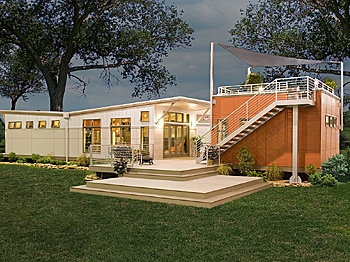Imagine purchasing a home that is predesigned to make life simple.
From the floor plan to the materials used in construction—a house that is brought to you in a kit and assembled on your land. Plus, it is energy efficient and environmentally friendly, and has open spaces, large windows, and modern finishes.
Think: IKEA, high efficiency appliances, a residence that is architecturally stimulating inside and out.
The housing style described is none other than a modern prefabricated home. And there are more names for it, such as, a green modular, a green prefab, or put simply: a prefab.
So what exactly is a prefab?
Generally speaking, it is a home that is constructed—or partially constructed—in a factory, then shipped to a specific building site, where the home is assembled.
Most companies advertise that prefabs cut down on costs and construction time, while improving the overall quality, and emphasizing characteristics of green building.
Through purchasing a prefab, one can acquire a new home, designed by an architecturally based company, meeting a desired aesthetic need while also minimizing the footprint left on the earth and future energy costs.
The downside though, in many cases, is that prefabs remain cost prohibitive. While in the end they may be a cheaper option than hiring an architect to build a custom designed, modern home, some of the more appealing prefabs can cost over $200 per square foot.
While price can be a hindrance with some prefab designs, there are options that seem to meet the dollar-for-quality challenge and are also what the general populace might consider as affordable.
From the floor plan to the materials used in construction—a house that is brought to you in a kit and assembled on your land. Plus, it is energy efficient and environmentally friendly, and has open spaces, large windows, and modern finishes.
Think: IKEA, high efficiency appliances, a residence that is architecturally stimulating inside and out.
The housing style described is none other than a modern prefabricated home. And there are more names for it, such as, a green modular, a green prefab, or put simply: a prefab.
So what exactly is a prefab?
Generally speaking, it is a home that is constructed—or partially constructed—in a factory, then shipped to a specific building site, where the home is assembled.
Most companies advertise that prefabs cut down on costs and construction time, while improving the overall quality, and emphasizing characteristics of green building.
Through purchasing a prefab, one can acquire a new home, designed by an architecturally based company, meeting a desired aesthetic need while also minimizing the footprint left on the earth and future energy costs.
The downside though, in many cases, is that prefabs remain cost prohibitive. While in the end they may be a cheaper option than hiring an architect to build a custom designed, modern home, some of the more appealing prefabs can cost over $200 per square foot.
While price can be a hindrance with some prefab designs, there are options that seem to meet the dollar-for-quality challenge and are also what the general populace might consider as affordable.






